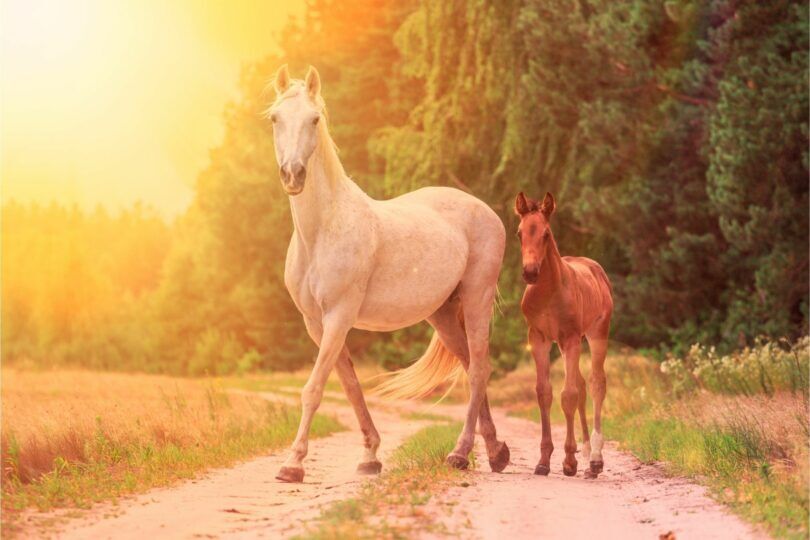Yes, (some) horses have udders!
Only mares (female horses) have an udder. If a mare has never given birth, it’s usually quite small, almost invisible except for two teats. Mares have multiple heat cycles, or times when they can get pregnant, between spring and fall. A typical equine pregnancy is eleven months. Foals will start to nurse, which is like breastfeeding in humans, a couple of hours after birth.
Equine Reproduction – The Basics
A healthy mare can produce one foal a year. Broodmares, or mares used exclusively for breeding, are typically bred soon after giving birth so they’ll have another foal around the same time next year.
When does a mare go into heat?
Mares go into heat multiple times during a breeding season, which lasts from late spring to early fall.
Expect a mare to go into heat about every three weeks, for anywhere from two to fourteen days (depending on whether it’s early or late in the season).
How long is a horse’s pregnancy?
On average, a mare will be pregnant for 11 months. According to John A Bukowski, DVM, “Gestation (pregnancy) lasts 330 to 342 days.”
Equine Lactation
Like all mammals, mares produce milk for their foals.
Do horses produce milk?
Female horses do! About 30 days or so before giving birth, a mare will start producing milk.
A mare pregnant with her first foal may secrete some milk before the foal is born or may not start producing milk until just before the foal is born.
Photo Cred: Canva
How many nipples do horses have?
Female horses (mares) have two teats, one for each mammary gland. They are quite small compared to other animals’ teats (like cows, which have four large ones).
As mentioned earlier, male horses (geldings or stallions) don’t have teats.
How common are swollen mammary glands in horses?
Swollen mammary glands are fortunately not very common in mares.
Mastitis, a type of inflammation caused by infection, is usually cleared up with a course of antibiotics.
Photo Cred: Canva
Frequently Asked Questions
Q: Do horses have periods?
Not in the same way that humans do. Unlike humans, horses don’t bleed if they don’t become pregnant.
Instead, they have heat cycles, which are time frames during which they can become pregnant.
Q: Do horses breastfeed?
Technically, a foal will nurse, not breastfeed. Within one to two hours after being born, they’ll start to suckle and will drink regularly (every few hours) for the first few months.
Photo Cred: Canva
Q: Can you milk a horse?
You can, though most people wouldn’t try to. Mares typically don’t produce an excess of milk, and what they do produce is needed for their foal.
However, there are some farmers in Europe who milk their post-pregnancy mares each day in order to flash-freeze and sell.
Photo Cred: Canva
Parting Thoughts
While mares produce milk for their foals, don’t expect to start seeing horse’s milk next to cow’s milk in the supermarket anytime soon. After eleven months of pregnancy, the mare deserves to keep it all for herself (and for her foal, of course).
P.S. Enjoy this article? Trot on over to:
- Horse Conformation Terminology Made Simple
- Horse care 101: Turnout blankets vs. stable blankets
- Horse Riding Equipment List: What You Need & What You Don’t
- Beginner’s Guide to Horse Hay Nets & Bags
- Horse Riding Gear for Beginners (Quick Print Equipment List)
- The Ultimate Packing & Horse Trailering Checklist
- What Gear Do You Need to Ride Horses as an Adult
